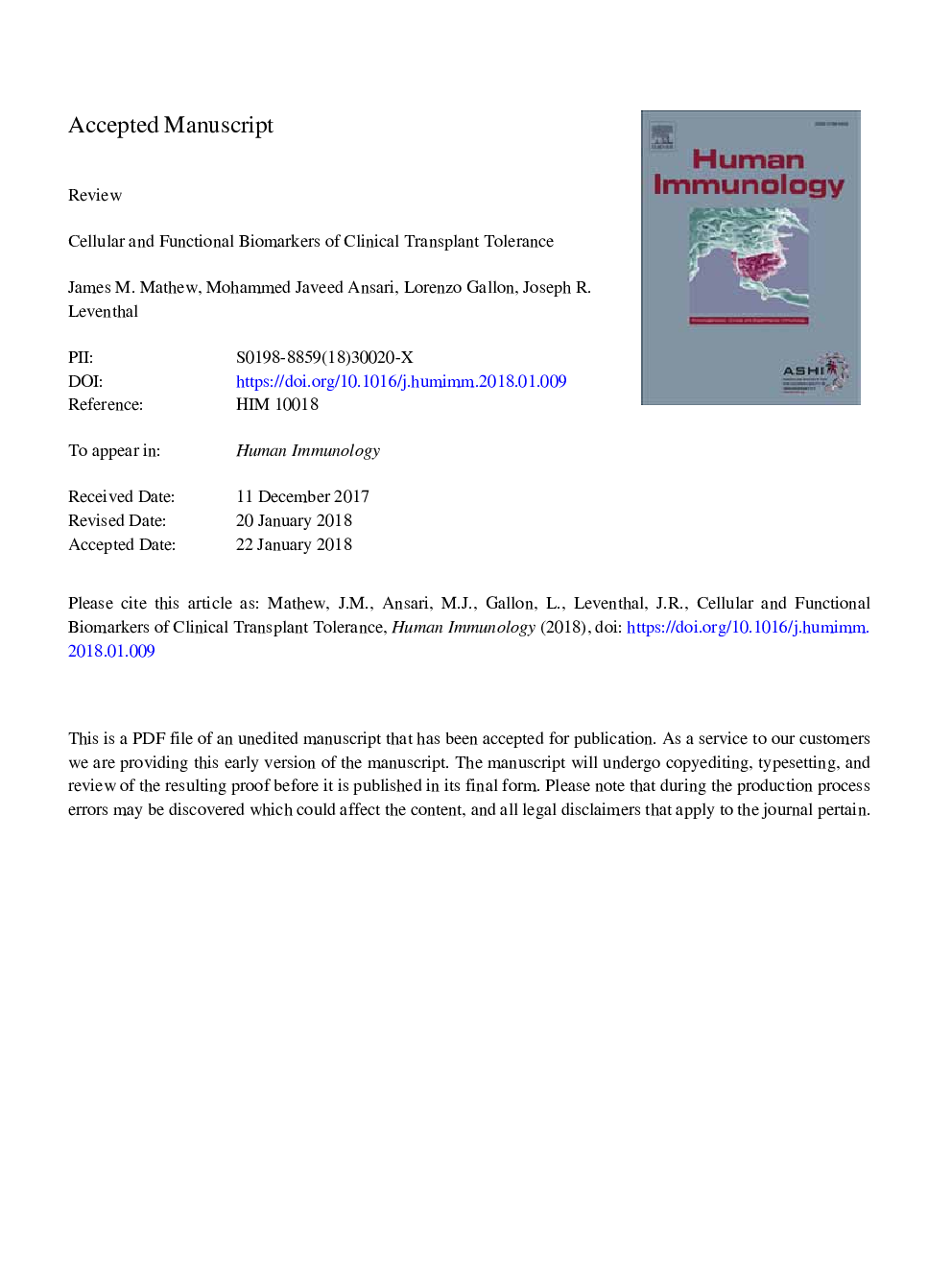| کد مقاله | کد نشریه | سال انتشار | مقاله انگلیسی | نسخه تمام متن |
|---|---|---|---|---|
| 8737626 | 1591367 | 2018 | 37 صفحه PDF | دانلود رایگان |
عنوان انگلیسی مقاله ISI
Cellular and functional biomarkers of clinical transplant tolerance
ترجمه فارسی عنوان
زیست شناسی سلولی و عملکردی تحمل بالینی پیوند
دانلود مقاله + سفارش ترجمه
دانلود مقاله ISI انگلیسی
رایگان برای ایرانیان
کلمات کلیدی
PMNMSCCMLCyTOFHSPsTLRCTLA-4CNIPRRDHSCDSATEXPRAELISPOTTregsHMGB-1CFSEGvHDBTLAB and T lymphocyte attenuatorTNFRCPMBasic leucine zipper transcription factorPD-L1MLRFOXP3CTLLAG-3KLRG1PD-1IL-BATFDAMPsnatural killer - (سلول های) کشنده طبیعیdonor-specific antibodies - آنتی بادی اختصاصی اهدا کنندهpanel reactive antibodies - آنتی بادی واکنش پذیر پانلHuman leukocyte antigen - آنتی ژن لوسکسی انسانHLA - آنتیژن گلبول سفید انسانیdamage-associated molecular patterns - الگوهای مولکولی مرتبط با آسیبEnzyme-linked immunospot - ایمنی مصنوعی مرتبط با آنزیمinterleukin- - اینترلوکینBregs - برگزCellular biomarkers - بیومارکرهای سلولیLDA - تخصیص پنهان دیریکلهTolerance - تلرانس Tim-3 - تیم 3Serum amyloid P component - جزء آمیلوئید P سرمforkhead box P3 - جعبه جعبه P3T cell exhaustion - خستگی سلول TMesenchymal stem cells - سلول های بنیادی مزانشیمیregulatory B cells - سلول های تنظیم کننده BRegulatory dendritic cells - سلولهای دندریتیک مقرراتیRegulatory T cells - سلولهای تی تنظیمکنندهcounts per minute - شمار در هر دقیقهSAP - شیرهcytotoxic T lymphocyte - لنفوسیت T سیتوتوکسیکMHC - مجموعه سازگاری بافتی اصلیmajor histocompatibility complex - مجموعه سازگاری بافتی اصلیlimiting dilution analysis - محدود کردن تجزیه رقتbone marrow - مغز استخوانcalcineurin inhibitor - مهار کننده کالسینورینmixed lymphocyte reaction - واکنش لنفوسیت مخلوطhigh mobility group box-1 protein - پروتئین جعبه 1 پروتئین گروه تحرک بالاcytotoxic T-lymphocyte-associated protein 4 - پروتئین مرتبط با لنفوسیت T تری سیتوتوکسی 4Heat-shock proteins - پروتئین های شوک حرارتC-reactive protein - پروتئین واکنشی سیCRP - پروتئین واکنشی سی یا سی. آر. پی Clinical transplantation - پیوند بالینیGraft versus host disease - پیوند در برابر بیماری میزبانLymphocyte activation gene 3 - ژن فعال سازی لنفوسیت 3carboxyfluorescein succinimidyl ester - کربوکسیفلوورسسین سوکسینیمیدیل استرtumor necrosis factor receptor - گیرنده فاکتور نکروز تومورpattern recognition receptors - گیرنده های تشخیص الگوToll-like receptors - گیرنده های پولی مانند
ترجمه چکیده
توسعه پروتکل های تحمل پذیری نیازمند تست ها یا بیومارکرهایی است که دریافت کننده های تحمل کننده را از غیر قابل تحمل تشخیص می دهد. علاوه بر این، درک کامل از مکانیزم های قابل قبول مرتبط با تحمل بالینی پیوند ضروری است تا زمینه را به جلو برداریم. بر خلاف اکثر تحلیل های امضای مولکولی که توسط دیگران مورد استفاده قرار می گیرند، تاکید این مقاله بر روی بیومارکر های سلولی و کاربردی تحمل پیوند القا شده است. ایمنی به پیوند عضو بسیار پیچیده است و شامل دو دسته گسترده ای می شود: پاسخ های ایمنی ذاتی و بدست آمده یا سازگاری. با استفاده از حذف یا جلوگیری از آسیب های ایسکمیک به ارگان اهدا کننده می توان ایمنی فاحشی را ایجاد کرد و تحمل در سطح ایمنی سازگار می تواند با تزریق تعدادی از محصولات سلولی ایجاد شود. از آنجاییکه پاسخ ایمنی انطباق شامل حساسیت التهابی، جنبه های سلولی (سیتوتوکسیک و کمر) و هومورال است، همه این ها باید اندازه گیری شوند و گیرندگان که عدم واکنش دهنده خاص را نشان می دهند، می تواند تحمل کننده یا کاندیدای کم کردن و / . مکانیسم هایی که این عوامل باعث تحمل تحمل پیوند می شوند عبارتند از: تنظیم، انسداد، خستگی، پیری و حذف سلول های ایمنی دریافت کننده. یکی دیگر از مکانیسم اثبات تحمل، کروموزوم کمک کننده یا کامل است. با این حال، باید هشدار داد که تحمل غیرقانونی میتواند معکوس شود.
موضوعات مرتبط
علوم زیستی و بیوفناوری
ایمنی شناسی و میکروب شناسی
ایمونولوژی
چکیده انگلیسی
Development of tolerance protocols requires assays or biomarkers that distinguish tolerant recipients from non-tolerant ones to be established. In addition, a thorough understanding of the plausible mechanisms associated with clinical transplant tolerance is necessary to take the field forward. Unlike the majority of molecular signature analyses utilized by others, the emphasis of this article is on the cellular and functional biomarkers of induced transplant tolerance. Immunity to an organ transplant is very complex, comprised of two broad categories - innate and acquired or adaptive immune responses. Innate immunity can be avoided by eliminating or preventing ischemic injuries to the donor organ and tolerance at the level of adaptive immunity can be induced by infusions of a number of cellular products. Since adaptive immune response consists of inflammatory hypersensitivity, cellular (cytotoxic and helper) and humoral aspects, all these need to be measured, and the recipients who demonstrate donor-specific unresponsiveness in all can be considered tolerant or candidates for immunosuppression minimization and/or withdrawal. The mechanisms by which these agents bring about transplant tolerance include regulation, anergy, exhaustion, senescence and deletion of the recipient immune cells. Another proven mechanism of tolerance is full or mixed donor chimerism. However, it should be cautioned that non-deletional tolerance can be reversed.
ناشر
Database: Elsevier - ScienceDirect (ساینس دایرکت)
Journal: Human Immunology - Volume 79, Issue 5, May 2018, Pages 322-333
Journal: Human Immunology - Volume 79, Issue 5, May 2018, Pages 322-333
نویسندگان
James M. Mathew, Mohammed Javeed Ansari, Lorenzo Gallon, Joseph R. Leventhal,
